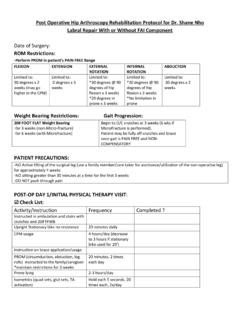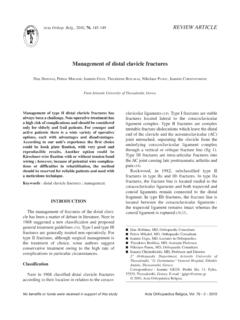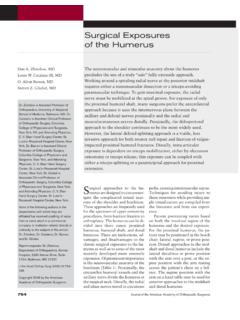Transcription of Management of Proximal Humeral Fractures Based on …
1 The PDF of the article you requested follows this cover page. This is an enhanced PDF from The Journal of Bone and Joint Surgery 2007;89:44-58. J Bone Joint Surg J. Nho, Robert H. Brophy, Joseph U. Barker, Charles N. Cornell and John D. MacGillivray LiteratureManagement of Proximal Humeral Fractures Based on CurrentThis information is current as of October 8, 2007 Reprints and PermissionsPermissions] link. and click on the [Reprints , or locate the article citation on to use material from thisorder reprints or request permissionClick here to Publisher Information Pickering Street, Needham, MA 02492-3157 The Journal of Bone and Joint SurgeryCOPYRIGHT 2007 BY THE JOURNAL OF BONE AND JOINT SURGERY, INCORPORATED44 Management of Proximal Humeral Fractures Based on Current LiteratureBy Shane J. Nho, MD, MS, Robert H. Brophy, MD, Joseph U. Barker, MD, Charles N. Cornell, MD, and John D.
2 MacGillivray, MDIntroductionroximal Humeral Fractures are the second most com-mon upper-extremity fracture and the third most com-mon fracture , after hip Fractures and distal radialfractures, in patients who are older than sixty-five years ofage1. Although the overwhelming majority of Proximal hu-meral Fractures are either nondisplaced or minimally dis-placed and can be treated with sling immobilization andphysical therapy, approximately 20% of displaced proximalhumeral Fractures may benefit from operative surgical techniques have been described, but no singleapproach is considered to be the standard of care. Surgeonswho treat Proximal Humeral Fractures should be able to iden-tify the fracture pattern and select an appropriate treatmenton the basis of this pattern and the underlying quality of thebone. Orthopaedic surgeons should have experience with abroad range of techniques, including transosseous suture fixa-tion, closed reduction and percutaneous fixation, open reduc-tion and internal fixation with conventional and locked-platefixation, and hemiarthroplasty.
3 In the future, locked-platetechnology and the use of osteobiologics may play an increas-ingly important role in the treatment of displaced proximalhumeral Fractures , facilitating preservation of the humeralhead in appropriately selected goals of this article are to enable the reader to: (1)become familiar with the recent literature on the classificationof and treatment options for Proximal Humeral Fractures , and(2) better identify fracture characteristics and devise an ap-propriate treatment OptionsTransosseous Suture FixationSurgical Techniqueark et described different operative approaches foreach fracture pattern described by Neer3. For two-partgreater tuberosity Fractures , an anterosuperior approachalong the Langer lines extending from the lateral aspect ofthe acromion toward the lateral tip of the coracoid is split occurs in the anterolateral raphe and allows expo-sure of the displaced greater tuberosity fracture .
4 When a sur-gical neck fracture exists, Park et prefer a standarddeltopectoral approach. Nonabsorbable suture is used tocapture rotator cuff tissue anteriorly, laterally, and posteri-orly to the fragment. The displaced Humeral head is reducedand fixed to the shaft through drill holes or suture Fractures involving the greater tuberosity and thesurgical neck can be repaired by initially bringing the head tothe shaft, followed by reduction and fixation of the greatertuberosity. Flatow et described an anterosuperior ap-proach and the use of heavy nonabsorbable sutures forgreater tuberosity Fractures (Fig. 1). IndicationsTransosseous suture fixation has been described as a treat-ment option for Proximal Humeral Fractures that have at least1 cm of displacement between the head and the shaft frag-ments or 5 mm of displacement of the tuberosity proponents of this technique emphasize the advantage ofavoiding the risks associated with hardware, which includepain, neurovascular compromise, migration, failure, and theneed for removal.
5 The underlying rotator cuff musculaturecan be used as a means to realign the Fractures and enhancestability. Furthermore, the long-term functional recovery ofthe rotator cuff is a key component of overall patient to this approach include previous at-tempt(s) at internal fixation or Fractures older than six , the use of this technique for highly comminuted four-part Fractures is not : The authors did not receive any outside funding or grants in support of their research for or preparation of this work. Neither they nor a member of their immediate families received payments or other benefits or a commitment or agreement to provide such benefits from a commercial entity. No commercial entity paid or directed, or agreed to pay or direct, any benefits to any research fund, foundation, division, center, clinical prac-tice, or other charitable or nonprofit organization with which the authors, or a member of their immediate families, are affiliated or associated.
6 J Bone Joint Surg Am. 2007;89(Suppl 3):44-58 Page 44 Monday, September 10, 2007 2:01 PM45 THE JOURNAL OF BONE & JOINT SURGERY 89-A SUPPLEMENT 3 2007 Management OF Proximal Humeral Fractures Based ON CURRENT LITERATURER esultsFlatow et reported that all twelve patients who had tran-sosseous suture fixation of an isolated greater tuberosity frac-ture had good or excellent results with osseous union. Parket , in a review of twenty-eight shoulders with two-partgreater tuberosity, two-part surgical neck, and three-partgreater tuberosity and surgical neck Fractures that were treatedwith transosseous suture fixation, reported that 78% of thepatients had an excellent result according to the criteria ofNeer et and that there was no difference between the re-sults obtained with two-part greater tuberosity Fractures andthose obtained with two-part surgical neck or three-part frac-tures.
7 Panagopoulos et used transosseous suture fixationfor four-part valgus-impacted Proximal Humeral Fractures ,and the mean Constant-Murley score7 for the operative shoul-der was 87 compared with 94 for the contralateral osteonecrosis of the Humeral head developed in Reduction and Percutaneous FixationSurgical TechniqueWith the aid of an image intensifier, the fracture is reduced byclosed means into anatomic alignment. For surgical neck frac-tures, two to three threaded Kirschner wires ( to ) are inserted into the lateral cortex distal to the deltoidinsertion and advanced into the subchondral bone of the hu-meral head without penetrating the articular surface. Forgreater tuberosity Fractures in isolation or in conjunction witha surgical neck fracture , the two wires should purchase themedial cortex >20 mm from the inferior border of the et described a technique for closed reductionand percutaneous fixation of three and four-part proximalhumeral Fractures .
8 For three-part Fractures , the subcapitalfracture is reduced with adduction, internal rotation, and axialtraction on the arm. A pointed hook retractor is inserted intothe subacromial space to manipulate the greater tuberosityfragment anteriorly and inferiorly into anatomic image intensification, the shoulder is brought throughinternal and external rotation to confirm reduction of thegreater tuberosity and two cannulated self-tapping are used to fix the four-part valgus impacted Fractures or true four-part Fractures , a periosteal elevator is used to elevate and la-terally translate the articular fragment9. When the head iselevated, the periosteum on the medial side acts as a hinge andthe greater tuberosity is reduced into anatomic position. Ablunt trocar and a cannulated screw is advanced to-ward the superior aspect of the greater tuberosity, and a screwis directed toward the Humeral head.
9 Another screw is posi-tioned at the inferior portion of the greater tuberosity and di-rected into the shaft to provide fixation between the head andshaft. The lesser tuberosity is provisionally fixed with a Kirsch-ner wire, and a screw is placed from anterior to are generally immobilized for three to fourweeks in most protocols. After this initial period, passive mo-tion is started, consisting of pendulum exercises, forward ele-vation, and external rotation with the arm at the side10. Activemotion starts at six weeks, provided that radiographs demon-strate evidence of fixation of Proximal Humeral Fractures requiresless dissection and therefore less disruption of the vascular sup-ply than traditional open approaches do. Advocates cite thehigh risk of osteonecrosis in these Fractures as an important rea-son to avoid extensive exposure of the individual fixation also has the advantage of decreased scar-ring in the scapulohumeral interface and subsequent include the presence of severe osteopeniaor osteoporosis.
10 Comminution of the medial portion of thecalcar or Proximal part of the Humeral shaft is also a relativecontraindication. Patients who are noncompliant or nonco-Fig. 1 Tension-band construct with transosseous suture fixation can be used for minimally displaced (AO/ASIF type-A) Proximal Humeral fracture involving the surgical neck, greater tuberosity, or lesser tuber-osity. (Reproduced with modification, with permission from: Nho SJ, Brophy RH, Barker JU, Cornell CN, MacGillvray JD. Innovations in the Management of displaced Proximal humerus Fractures . J Am Acad Or-thop Surg. 2007;15:17.) Page 45 Monday, September 10, 2007 2:01 PM46 THE JOURNAL OF BONE & JOINT SURGERY 89-A SUPPLEMENT 3 2007 Management OF Proximal Humeral Fractures Based ON CURRENT LITERATURE operative should not be treated with this technique. Tuberos-ity comminution that prevents screw or pin fixation precludesuse of this technique.










